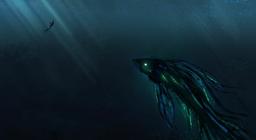
G8Bi 5.3 Living in the Dark (Comprehension)
Quiz by Janette Salinas
Feel free to use or edit a copy
includes Teacher and Student dashboards
Measure skillsfrom any curriculum
Measure skills
from any curriculum
Tag the questions with any skills you have. Your dashboard will track each student's mastery of each skill.
With a free account, teachers can
- edit the questions
- save a copy for later
- start a class game
- automatically assign follow-up activities based on students’ scores
- assign as homework
- share a link with colleagues
- print as a bubble sheet
40 questions
Show answers
- Q1What is a whale fall?The carcass of a dead whale that has sunk to the ocean floor.A rare species of whale.A whale that has washed up on a beach.A type of whale migration pattern.30s
- Q2What happens to a whale carcass during a whale fall?It creates a unique ecosystem that supports a variety of marine life.It remains untouched and slowly floats back to the surface.It has no effect on the surrounding marine environment.It is quickly consumed by scavengers such as dolphins.30s
- Q3Where do most whale falls occur?On the surface of the ocean.In shallow waters near the coast.In freshwater rivers and lakes.On the ocean floor, usually at depths of over 1,000 meters.30s
- Q4Which of the following animals is not typically found at a whale fall?Sharks.Dolphins.Hagfish.Crabs.30s
- Q5How long does a whale fall ecosystem typically last?Several years.Decades or more.Several months.Only a few weeks.30s
- Q6Which of the following is not a benefit of studying whale falls?Discovering new species of whales.Learning about the process of decomposition.Understanding how the ocean functions as a system.Gaining insight into the life cycles of marine organisms.30s
- Q7Why are whale falls important to the marine ecosystem?They create a safe haven for endangered species.They serve as a warning sign of environmental degradation.They help to regulate the marine food web.They provide a source of nutrients to organisms that would not otherwise have access to them.30s
- Q8What are hydrothermal vents most like?GlaciersVolcanoesGeysersWaterfalls30s
- Q9What do hydrothermal vents release?Minerals and gasesPlants and animalsOil and gasWater and sand30s
- Q10What type of microorganisms are found near hydrothermal vents?SharksDolphinsBacteriaFish30s
- Q11What is the color of hydrothermal vent water?BlueGreenRedBlack30s
- Q12What are cold seeps?Areas where methane and other hydrocarbons escape from the seafloorAreas where hot lava erupts from the seafloorAreas where freshwater springs emerge from the seafloorAreas where warm water continuously flows from the seafloor30s
- Q13What types of organisms are commonly found at cold seeps?Phytoplankton, fish, and jellyfishSeagulls, crabs, and clamsChemosynthetic bacteria, tube worms, and musselsSharks, dolphins, and whales30s
- Q14Which of the following correctly explains the symbiotic relationship between chemosynthetic bacteria and tube worms at cold seeps?The tube worms consume the bacteria, which in turn consume methaneThe bacteria and tube worms compete for resources and territoryThe bacteria provide food for the tube worms, and the tube worms provide a home for the bacteriaThe bacteria cause disease in the tube worms, which in turn provide nutrients for other organisms30s
- Q15What is the importance of cold seeps in regulating climate?Cold seeps have no effect on the global climate.Cold seeps actually remove methane from the ocean and atmosphere, reducing greenhouse gas emissions.Cold seeps trap large amounts of methane deep in the ocean, reducing greenhouse gas emissions.Cold seeps release significant amounts of methane into the ocean and atmosphere, contributing to greenhouse gas emissions.30s